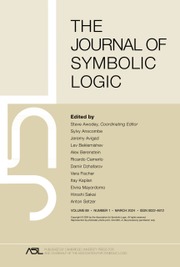Article contents
A generalization of the concept of ω-consistency1
Published online by Cambridge University Press: 12 March 2014
Extract
In this paper we consider certain formal properties of deductive systems which, in special cases, reduce to the property of ω-consistency; and we then seek to understand the significance of these properties by relating them to the use of models in providing interpretations of the deductive systems.
The notion of ω-consistency arises in connection with deductive systems of arithmetic. For definiteness, let us suppose that the system is a functional calculus whose domain of individuals is construed as the set of natural numbers, and that the system possesses individual constants ν0, ν1, ν2, … such that νi functions as a name for the number i. Such a system is called ω-consistent, if there is no well-formed formula A(x) (in which x is the only free variable) such that A(ν0), A(ν1), A(ν2), … and ∼(x)A(x) are all formal theorems of the system, where A(νi) is the formula resulting from A(x) by substituting the constant νi for each free occurrence of the individual variable x.
Now consider an arbitrary applied functional calculus F, and let Γ be any non-empty set of its individual constants. In imitation of the definition of ω-consistency, we may say that the system F is Γ-consistent, if it contains no formula A(x) (in which x is the only free variable) such that ⊦ A (α) for every constant α in Γ, and also ⊦ ∼(x)A(x) (where an occurrence of “⊦” indicates that the formula which it precedes is a formal theorem). We easily see that the condition of Γ-consistency is equivalent to the condition that the system F contain no formula B(x) such that ⊦ ∼ B(α) for each α in Γ, and also ⊦ (∃x)B(x).
Information
- Type
- Research Article
- Information
- Copyright
- Copyright © Association for Symbolic Logic 1954
Footnotes
This work was supported in part by a grant from the National Science Foundation.
References
2 An important application of the concept of ω-consistency occurs in Gödel, K., Über formal unentscheidbare Sätze der Principia Mathematica und verwandter Systeme I, Monatshefte für Mathetnatik und Physik, vol. 38 (1931), pp. 173–19810.1007/BF01700692CrossRefGoogle Scholar. Also see Tarski, A., Einige Betrachtungen über die Begriffe der ω-Widerspruchsfreiheit und ω-Vollständigkeit, Monatshefte für Mathetnatik und Physik, vol. 40 (1933), pp. 97–112CrossRefGoogle Scholar.
3 See Gödel, K., Die Vollständigkeit der Axiome des logischen Funktionenkalküls. Monatshefte für Mathematik und Physik, vol. 37 (1930), pp. 349–36010.1007/BF01696781CrossRefGoogle Scholar.
4 This method has found frequent application in the establishment of decision procedures for certain functional calculi. See, for instance, Löwenheim, L., Über Möglichkeiten im Relativkalkül, Mathematische Annalen, vol. 76 (1915), pp. 447–470CrossRefGoogle Scholar.
5 See Henkin, L., The completeness of the first-order functional calculus, this Journal, vol. 14 (1949), pp. 159–166Google Scholar. Also Hasenjaeger, G., Eine Bemerkung zu Henkin's Beweis für die Vollständigkeit des Prädikatenkalküls der ersten Stufe, this Journal, vol. 18 (1953), pp. 42–48Google Scholar.
6 For details, consult the references given in footnote 5.
- 30
- Cited by

